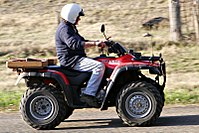
Photo from wikipedia
Preventable deaths and serious injuries of riders and passengers on quad bikes continue to occur in Australian workplace and recreational settings. Inherent engineered instability and oversteer characteristics in this heavy… Click to show full abstract
Preventable deaths and serious injuries of riders and passengers on quad bikes continue to occur in Australian workplace and recreational settings. Inherent engineered instability and oversteer characteristics in this heavy piece of machinery, which often lacks occupant protection, are material contributors to many of these deaths and serious injuries. This includes lateral and pitch instability, leading the quad bike to rollover, with minimal warning, when turned or as a result of a minor unilateral bump-obstacle impact. This can occur even at low speeds but is a particular risk on uneven and sloping surfaces. To prevent entrapment and crushing of the rider, which might otherwise occur with a quad bike rollover, there is often a requirement for rapid counterintuitive recovery manoeuvres by the rider (often called ‘Active Riding’ by quad bike manufacturers). Rider education, training and experience, while acknowledged to be valuable, cannot be relied upon to wholly mitigate these risks. Even riders with many years of experience and extensive quad bike use have been caught off guard, rolled and been found crushed under these machines – with no physical injuries other than the weight of the quad bike asphyxiating them. Children are particularly vulnerable because they are less likely to perceive hazards, lack the cognitive and physical skills and have a low body mass and physical reach to execute such active riding manoeuvres successfully. The paper by Liddle et al., which reports for the first time a series of quad bike injuries managed in the Northern Territory in the decade till 2015, has highlighted the exacerbating risks riders are exposed to, including alcohol ingestion, an absence of helmet wearing and riding on quad bikes not fitted with an operator protection device (OPD). A rising incidence of injured quad bike riders and passengers managed in the Royal Darwin Hospital is documented. Implementation of evidence-based changes to mitigate the inherent risks associated with quad bike use has been slow. The Royal Australasian College of Surgeons (RACS) is one of many member organizations of the Trans-Tasman Quad Bike Project Reference Group, which includes the Federal Chamber of Automotive Industries and quad bike manufacturers and distributors. In October 2014, preliminary release of static and dynamic quad bike rollover test results by The University of New South Wales Transport and Road Safety Research Centre staff to this group highlighted the problem. In addition, successive state coroners’ reports on quad bike-related deaths in Queensland (March 2015), Victoria (August 2015) and New South Wales (November 2015) delivered consistent messages inferring the inherent instability of quad bikes. This cumulative stakeholder input over several decades has culminated in the recent requirement by the Australian Competition and Consumer Commission for quad bikes sold in Australia to be fitted with a rollover OPD. Beyond these requirements, there is a strong impetus for the quad bike manufacturing industry to consider further design modifications to improve rider safety. On 10 October 2019, the Australian Competition and Consumer Commission welcomed the Australian Federal Government’s decision to improve the safety of quad bikes by introducing a new safety standard, a decision reached following concerted advocacy from farming, safety and health representatives, including RACS. The new safety standard has three elements: improved information for potential purchasers, enhanced quad bike stability and rollover protection to reduce injuries and deaths. The standard requires that, within 12 months, all new quad bikes will need to have information affixed to them about the degree of slope at which they will start to overturn. Within 24 months, all new general-use quad bikes will need to conform with minimum standards for stability on slopes. The standard will also require that, within 24 months, all new general-use quad bikes sold in Australia must have an OPD or rollover bar to reduce the risk of serious crush injuries and deaths in the event of a rollover. While RACS welcomes these regulations and standards, it will be some time until we see their mitigating effect on the number of deaths and serious injuries. There are almost 300 000 quad bikes in the existing fleet, and they are being replaced at approximately 10 000 units per year. The new requirement for OPD does not start for 2 years, so predictably, many more preventable deaths are expected with the current rate of quad bike-related injuries described in Australia and New Zealand. States and Territories must act to mandate a requirement for OPD to be fitted to the large fleet of existing quad bikes, at least for those used in the workplace, if it cannot be mandated for all vehicles. Alternatively, quad bikes could be replaced with welldesigned, more stable, side-by-side vehicles, properly fitted with seatbelts and OPD and good occupant containment. Without this, we will not see the kind of safety improvements we all desire so much, and for which RACS has been a strong advocate. The safety evidence is now sufficiently robust to push for this requirement (OPDs) regardless of whether each jurisdiction provides a rebate or subsidy scheme or not. Since Victoria mandated OPD in 2016, and has actively enforced that requirement, there has been no workplace-related quad bike fatality in that jurisdiction since 2017. With regard to the use of quad bikes by children, it is well recognized that children are at increased risk of death and injury due to quad bike trauma. There is unanimous support from industry, farming,
Journal Title: ANZ Journal of Surgery
Year Published: 2020
Link to full text (if available)
Share on Social Media: Sign Up to like & get
recommendations!